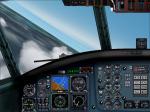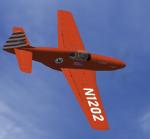All Files > Page 3

Bloch MB.152-C1
(Category: CFS2 > Aircraft)
9.93Mb (39 downloads)
MB.152 No. 198 (Y-685),
Unit: GC II/9 1re escadrille, September 1940
Pilot: unknown
The M.B.150 series began life in answer to the same 1936 specifications that led to the Dewoitine D.520, although Bloch elected to use a relatively untried Gnome-Rhone radial engine. It was designed from the outset as a bomber interceptor, not a pure fighter. The first prototype MB 150 proved to be a disappointing performer. But it was only one of two designs coming close to the specifications and with tensions rising with Germany, it was deemed too late to return to the drawing board. In a series of modifications in 1938-39, first the MB.151 and then the MB.152 with a slightly more powerful engine version were developed. While the MB.151 didn't provide what was wanted, the MB.152 got a little closer. Regardless, in an effort to fill the gap, orders were placed in 1939 for 400 planes, 60 of which were the MB 151 while the rest were the MB.152.
The first planes entered French squadron service in November 1939, while early in 1940 several MB 151s went to the Greek Air Force. When the Germans invaded France in 1940 the MB 151/152 equipped II/1, III/9, II/10, III/10 and II/6 Groupes of the Armee de l'Air and Escadrille AC-3 of the Aeronautique Navale. The MB.152 was effective against the Do-17 and He-111 when it could intercept the bombers without their Bf 109 escort, but it even had difficulty in fighting the Bf 110C. Following the armistice, it was one of the allowed types to equip the Vichy l'Armee de l'Air de l'Armistice. In 1941, it was removed from service and replaced completely by the D.520.
Credits
Captain Kurt: Aircraft model, VC, paint textures, aircraft flight files, and .dp
The pilot is a mashup of Captain Kurt, Wolfi and Dave Eckert
Kelticheart: Prop blurred texture
The panel is by Morton, with CK modifications by permission
A special credit goes Klein who converted the FXS Restauravia MB152 gauges to CFS2 gauges and to Huub Vink who arranged the Restauravia permission.
Posted Dec 2, 2025 16:07 by Captain Kurt

Messerschmitt Bf 108 B-1 Taifun
(Category: CFS2 > Aircraft)
7.28Mb (34 downloads)
Messerschmitt Bf 108 B-1 Taifun
Unit: IV/JG51 Somewhere in Russia, 1941
The Bf-108 Taifun (Typhoon) was a four passenger cabin monoplane built by the Bayerische Flugzeugwerke originally as a civilian light aircraft. The design by Prof. Willy Messerschmitt in 1933 was the forerunner of the famous BF-109 Messerschmitt fighter.
The type's appearances at various parts of the world helped to bolster the reputation of both Messerschmitt and the German aeronautical sector in general. Throughout the mid-to-late 1930s, the Bf 108 was a common sight at aerial competitions, commonly placing in either first or second place in events such as the 1937 Oases rally in Egypt and the 1938 Belgian international Queen Astrid Race. Furthermore, during July 1939, one aircraft established a new altitude class record of 9,075m (29,766ft).
Of the 885 airplanes built, 626 entered service in the Luftwaffe. These were attached to combat groups and squadrons for miscellaneous duties, and Luftwaffe headquarters at various levels. For use in North Africa, some of the aircraft were modified to the Bf 108B-2 / trop variant. Also Bf 108 s served in the so-called "German Air Service" (Deutsche Luftdienst), where they were used for various liason purposes. They were also assigned to training schools, but there they were used most often as messengers, and not training.
Credits
Wolfi and Captain Kurt collaboration: Aircraft model
Captain Kurt: VC model, 2D panel, textures, and flight models
Shessi, Wolfi and Captain Kurt: Pilot figure
Gauges by: FSD, MAPE, Microsoft, and unknown authors
Prop spinning disc texture by:Kelticheart
Sound: Skysong Soundworks
Posted Dec 2, 2025 16:03 by Captain Kurt


HU-16_METAL_HAF
(Category: FS2004 > Props)
20.60Mb (109 downloads)
Albatross HU-16T!!!
After your request I made it.
I draw this airplane, which is a remake of HU-16A with turbo prop engines.
The package include:
High resolution textures with reflections, BLANK!!!, so you
can repaint with your own textures if you wish),
Full moving parts, panel, and checklist.
I want to have a small file, that's why I used default sounds, and most of the default gauges as well.
The 3Dmodel, panel & airfile and textures was made it by Anthony Konstantinidis
Some gauges by unknown authors.
Posted Dec 2, 2025 08:52 by Anthony Konstantinidis

FSX/P3D Boeing 737 Max 8 Batik Air Malaysia package
(Category: FSX > Civil Jets)
85.10Mb (161 downloads)
FSX/P3D Boeing 737 Max 8 Batik Air Malaysia package. With its main hub at Kuala Lumpur International Airport, Batik Air Malaysia currently operate 17 Boeing 737 Max 8 flying to destinations all over Asia as well as Australia and New Zealand.
The high spec Boeing 737-Max 8 from TDS. The virtual cockpit (VC) is the Microsoft/Alejandro Rojas Lucena/FSND base modified by Speedbird77 to resemble a Max cockpit, including gauges by G. Munro.
There are custom CFM eco sounds included for that extra realism. Use - Instrument panel - Util for ground vehicles, doors stairs, fuel truck, buses. New Utility allows Bus, fuel, doors and more. (Go to Views - Instrument panel - Utility). VC added and edited to allow correct VC views, correct jetways and wheel levels. Credits go to TDS fantastic native FSX Boeing Max8 model. I added PDF B737 checklist.
Textured, packaged and prepared for FSX & P3D by Chris Evans.
Posted Dec 1, 2025 15:07 by chris evans
Hughes H500
(Category: FS2004 > Helicopters)
14.49Mb (92 downloads)
Hughes H500 for FS2004 3 models and 18 textures.
Is one of the world's most popular light turbine helicopters. It's rugged construction, operational performance and reliability combined with crisp handling and manoeuvrability make it the favourite of many helicopter pilots.\n\nSeveral different civilian and military versions have been built. Civilian versions include, amongst others, the 500C and 500D (1000 examples built since 1975), 500E (with longer fuselage, in production since 1982), 530E (new 485 kW engine built since 1983).
atc_heavy=0The Hughes 500 is one of the world's most popular light turbine helicopters. It's rugged construction, operational performance and reliability combined with crisp handling and manoeuvrability make it the favourite of many helicopter pilots.
Several different civilian and military versions have been built. Civilian versions include, amongst others, the 500C and 500D (1000 examples built since 1975), 500E (with longer fuselage, in production since 1982), 530E (new 485 kW engine built since 1983).
Posted Nov 29, 2025 20:14 by Anthony Konstantinidis


FSX/FS2004 N.A. P-51C Mustang N1202 “Excalibur III”
(Category: FSX > Vintage)
7.37Mb (179 downloads)
MSN 111-29080 was built in Dallas in 1944 and delivered to the USAF as 44-10947. After the war, it was sold to Paul Mantz as NX1202. Mantz converted the aircraft to a “wet” wing where the complete wing is a fuel tank. He then won the 1946 and 1947 Bendix Trophy Races, and, with different pilots in the cockpit, NX1202 came second in the 1948 Bendix race, and third in the 1949 race. Mantz then sold the aircraft to Captain Charles Blair who, on January 31, 1950, set a world record flying from New York to London in 7 hours and 48 minutes. On May 29, 1950, Captain Blair flew from Bardfoss, Norway, over the North Pole to Fairbanks, Alaska, in another world record of 10 hours 27 minutes. He then set yet another world record by flying from Fairbanks to New York in 9.5 hours. In 1952 Captain Blair was awarded the Harmon International Trophy by President Truman. N1202 was sold to Pan American World Airways in 1953, who promptly donated her to the Smithsonian Institute. Today, she is on display at the Udvar-Hazy Center in Washington DC.
Painted on to A.F. Scrub’s magnificent P-51B Mustang, I have modified, with permission, the wing to give Trans-Continental and Trans-Atlantic range. Enjoy
Posted Nov 29, 2025 19:20 by Steve Morley


do-1286 ALBATROS
(Category: FS2004 > Props)
7.27Mb (55 downloads)
FS2004 Dornier 128-6 the unfinished" Detailed Gmax rebuild with completely instrumented flyable VC though with FS2004-style levers and unfinished interior. Just about all that moves on the real thing moves accordingly here. Further improved flight characteristics using the FS9 turboprop model now featuring properly flat-rated PT6A-110 engines. gmax design partner Antonis "Anthony" Konstantinidis reappears again (the detailed outside texturing is also by him) Probable FS-first: VHF Homing Indicator by Roman Stoviak. Panel, most gauge programming, soundset and flight dynamics by Mathias Elsaesser.
Posted Nov 29, 2025 17:39 by Anthony Konstantinidis

CYUL Montreal Dorval
(Category: FS2004 > Scenery)
6.64Mb (18 downloads)
This scenery is based on a chart in the Pan Am Atlantic Division Manual for 1946 and is intended to cover propliner operations at Dorval down to about the mid 1950s. The hangars and terminal are custom built.
Posted Nov 29, 2025 15:58 by Ken Lawson


DO_1286 bare METAL
(Category: FS2004 > Props)
68.90Mb (71 downloads)
FS2004 Dornier 128-6 the unfinished" Detailed Gmax rebuild with completely instrumented flyable VC though with FS2004-style levers and unfinished interior. Just about all that moves on the real thing moves accordingly here. Further improved flight characteristics using the FS9 turboprop model now featuring properly flat-rated PT6A-110 engines. gmax design partner Antonis "Anthony" Konstantinidis reappears again (the detailed outside texturing is also by him) Probable FS-first: VHF Homing Indicator by Roman Stoviak. Panel, most gauge programming, soundset and flight dynamics by Mathias Elsaesser.
Posted Nov 28, 2025 20:51 by Anthony Konstantinidis

FSX/P3D Airbus A321NEO Air Busan package
(Category: FSX > Civil Jets)
90.70Mb (209 downloads)
FSX/P3D Airbus A321NEO Air Busan package. Air Busan is a South Korean low cost airline based in Busan. Air Busan currently operate 5 A321NEO flying to destinations all over Asia.
Model by Project Airbus with NEO engine mod by Bret Herman. Updated VC by Speedbird77 with built in FMC by Garret Smith. Includes A320 operation manual and checklist. PW sounds included. Textured, assembled for P3D v5.4 by Chris Evans. Should work in FSX and other P3D
Posted Nov 27, 2025 16:45 by chris evans






